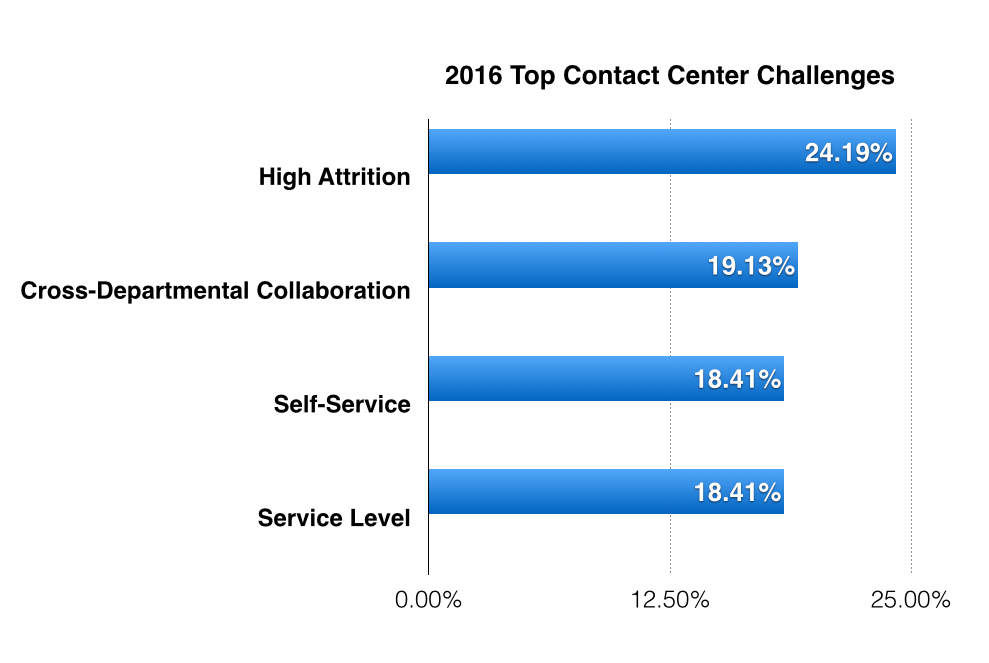A new study from the contact center consulting firm Strategic Contact outlines the top contact center challenges for 2016.
The results appeared in the January issue of Contact Center Pipeline. I’ve summarized a few highlights here, but the full article is a fascinating read.
What really jumped out is how the top challenges are all related to another topic I’ve been covering in this blog: operations. You can read the other posts in my ongoing series here.

Results
The graph above shows the top four contact center challenges that were called out in Strategic Contact’s report.
Look closely and you’ll see all of these issues are interconnected. Addressing them requires a holistic approach.
Attrition
Many contact centers make the mistake of trying to fix attrition by focusing on motivation. They offer their agents games, prizes, and incentives in an effort to make a crappy job seem better.
It rarely works. In reality, the average contact center agent becomes increasingly dissatisfied the longer they’re on the job.
Smart contact centers address the root cause. What contact center agents really want is to find meaning in their work. They want to solve problems and help customers.
Cross-Departmental Collaboration
That leads us to working with other departments.
This is key because many of the issues that contact center agents are asked to resolve are out of their control. They must rely on other departments to help make things right.
Here are just a few examples:
- Defective products
- Shipping errors
- Misleading marketing messages
- Buggy software
- Inadequate online support
It’s important to remember that customer service is only as good as the weakest link in the chain.
Insufficient Self-Service
Most of your customers would rather solve the problem themselves.
That means visiting the self-service section of your website. Recently, I wrote about a 2015 Microsoft study that found 57 percent of customers look for self-service before calling.
Unfortunately, contact centers usually need to rely on other departments to help them beef up their self-service offers. That brings us right back to cross-departmental collaboration.
Service Levels
A contact center service level is defined as the percentage of calls answered within a certain time limit. For example, a contact center might have a service level goal of answering 90 percent of calls within 15 seconds.
A vicious cycle of problems can make it hard to achieve service level goals.
High attrition leaves contact centers short-staffed, which in turn leads to longer wait times. Poor cross-departmental cooperation allows chronic problems to go unsolved. This generates more contacts, especially when customers aren’t able to get self-service.
More contacts also drives up wait times, which reduces service levels.
Solutions
Working with other departments is the key to addressing all of these challenges. I reached out to Lori Bockland, President of Strategic Contact, to ask her what contact center leaders should do.
Here’s what she told me:
“I have two favorite tactics contact center leaders can use to engage others to tackle the bigger problems.
First, invite leaders in other departments to observe contact handling – routinely. It seems simple, a no-brainer, but it doesn’t happen enough. Light bulbs can go off when it does.
Second, create a metrics scorecard specifically to communicate impacts and opportunities to other departments, and routinely share it with peers. It doesn’t have to be too “in your face” but it can convey opportunities like reducing volume, handle time, and transfers (and therefore, improving the customer experience – not to mention corporate costs!) if we all work together.
It needs to show what happened, and include a little bit of (credible) insight into why. The scorecard becomes a tool to generate productive conversations.”
Imagine all the things that will fall into place if you can get other departments onboard:
- You’ll solve more chronic problems.
- Fewer problems means fewer contacts.
- Fewer contacts leads to better service levels.
All of those things make your agents’ jobs better. Creating better jobs will help you improve attrition rates.
Resources
Lori will be conducting several workshops and sessions at ICMI’s Contact Center Expo, May 10 – 13 in Long Beach, California.
The conference itself features site tours, workshops, keynotes, breakout sessions, and an expo hall. I’ve attended the past several years and highly recommend it.
Here’s a registration link. You can save $200 on your registration fee if enter code SPKR at checkout.



